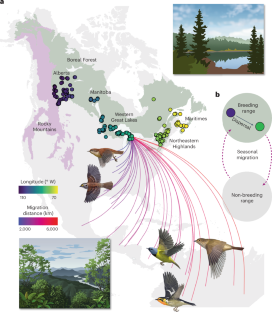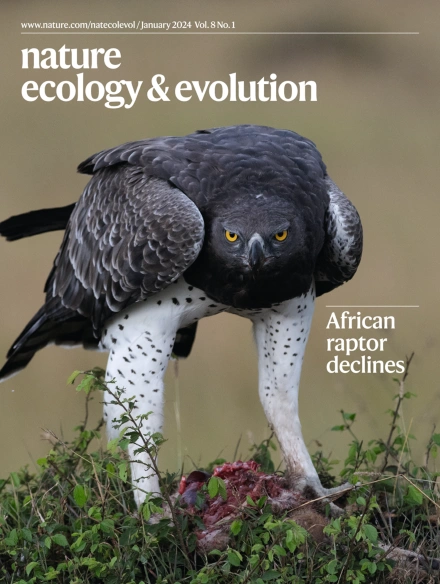Long-distance seasonal migration to the tropics promotes genetic diversity but not gene flow in boreal birds
IF 13.9
1区 生物学
Q1 ECOLOGY
引用次数: 0
Abstract
Differences in life history can cause co-distributed species to evolve contrasting population genetic patterns, even as they occupy the same landscape. In high-latitude animals, evolutionary processes may be especially influenced by long-distance seasonal migration, a widespread adaptation to seasonality. Although migratory movements are intuitively linked to dispersal and therefore promotion of gene flow, their evolutionary genetic consequences remain poorly understood. Using ~1,700 genomes from 35 co-distributed boreal-breeding bird species that differ in non-breeding latitude and thus migration distance, we find that most long-distance migrants unexpectedly exhibit spatial genetic structure, despite their strong movement propensity. This result suggests evolutionary effects of philopatry—the tendency of many migrants to return to the same breeding site year after year, resulting in restricted dispersal. We further demonstrate that migration distance and genetic diversity are strongly positively correlated in our study species. This striking relationship suggests that the adaptive seasonal shifts in biogeography inherent to long-distance migration may enhance population stability, preserving genetic diversity in long-distance migrants relative to shorter-distance migrants that winter in harsher conditions at higher latitudes. Our results suggest that the major impact of long-distance seasonal migration on population genetic evolution occurs through promotion of demographic stability, rather than facilitation of dispersal. Comparative analysis of genomes of 35 boreal-breeding bird species with different migratory distances shows that long-distance migrants have spatial genetic structure, despite their longer movements, and higher genetic diversity than short-distance migrants.


向热带地区的长途季节性迁徙促进了北方鸟类的遗传多样性,但没有促进基因流动
生活史上的差异会导致共同分布的物种进化出截然不同的种群遗传模式,即使它们占据着相同的景观。在高纬度动物中,进化过程可能特别受到长距离季节性迁徙的影响,这是一种对季节性的广泛适应。虽然迁徙运动直观地与扩散联系在一起,因此促进了基因流动,但它们的进化遗传后果仍然知之甚少。通过对35种共分布的北方繁殖鸟类的约1700个基因组的分析,我们发现,尽管它们具有强烈的迁徙倾向,但大多数长途迁徙鸟类却意外地表现出空间遗传结构。这一结果表明了亲缘关系的进化效应——许多候鸟年复一年地回到同一个繁殖地的趋势,导致它们的扩散受到限制。我们进一步证明,在我们研究的物种中,迁移距离与遗传多样性呈强正相关。这一惊人的关系表明,长途迁徙所固有的生物地理适应性季节变化可能会增强种群稳定性,相对于在高纬度地区严酷条件下过冬的短距离迁徙者,保持长途迁徙者的遗传多样性。我们的研究结果表明,长距离季节性迁徙对种群遗传进化的主要影响是通过促进种群稳定性,而不是促进分散。
本文章由计算机程序翻译,如有差异,请以英文原文为准。
求助全文
约1分钟内获得全文
求助全文
来源期刊

Nature ecology & evolution
Agricultural and Biological Sciences-Ecology, Evolution, Behavior and Systematics
CiteScore
22.20
自引率
2.40%
发文量
282
期刊介绍:
Nature Ecology & Evolution is interested in the full spectrum of ecological and evolutionary biology, encompassing approaches at the molecular, organismal, population, community and ecosystem levels, as well as relevant parts of the social sciences. Nature Ecology & Evolution provides a place where all researchers and policymakers interested in all aspects of life's diversity can come together to learn about the most accomplished and significant advances in the field and to discuss topical issues. An online-only monthly journal, our broad scope ensures that the research published reaches the widest possible audience of scientists.
 求助内容:
求助内容: 应助结果提醒方式:
应助结果提醒方式:


